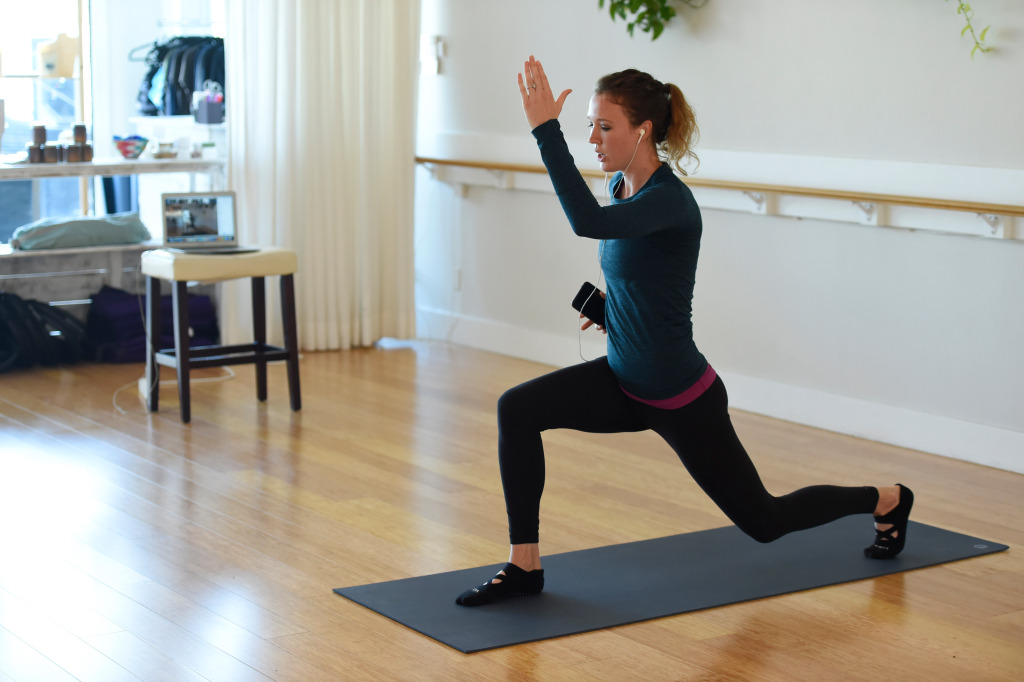CLICK HERE if you are having a problem viewing the photos on a mobile device
Clad in black leggings and grip socks, Katy Winter strides into Vita, her Oakland-based fitness studio. She’s all primed to teach a power Pilates class to a group of clients, only the place is completely empty.
No worries. Winter unfurls a yoga mat upon the gleaming wooden floor, props her MacBook laptop on a cushioned stool and gazes into the screen. Twelve faces in little Zoom squares smile back at her.
“How are you holding up?” she asks. “Go ahead and start your playlists, and let’s get going, everyone!”
Behold the virtual new fitness normal. Ordered to close their doors as part of the COVID-19 lockdown, resilient gyms, dance studios and other facilities have turned to online platforms to help participants stay active, get motivated and find their Zen without leaving their living rooms.
It’s a far cry from the days when Jane Fonda, all aglow in neon spandex, urged millions to get their sweat on via VHS videotapes. But with modern audio-visual technology making real-time interaction possible, the rise of — and return to — home fitness has proven a blessing on many levels.
“We’ve had some of our clients talk about how they’re dealing with depression and anxiety during these challenging times. How they’re crying all day and can’t get off the couch,” Winter says. “I tell them, just try giving us 45 minutes or so. Get the blood flowing. You’ll feel so much better.”
Of course, the instructors and facilities also benefit, as the coronavirus closures have many of them struggling to stay afloat.
Jordan Schreiber, who owns the ATA Martial Arts Leadership Academy in Martinez, is facing his biggest fiscal hurdle ever, and that’s saying a lot, considering he opened his business in 2007 — just as the recession started to hit.
“That was nothing compared to this,” he says. “This has been incredibly brutal.”
Stefan Trandafirescu, a dance instructor who owns The Rose Ballroom in San Jose, can relate. With his revenue in a free-fall and a strident landlord offering no breaks in rent, he claims the recent months have been “very, very painful.”
And so they’re forced to adapt or wither away. To survive, many of them are leaning into things that weren’t exactly in their wheelhouse: working with camera equipment, video monitors, headsets and unfamiliar software platforms — all while trying to hone their on-screen magnetism.
“That’s part of the fun and the challenge of it,” says Randy Myers, a Berkeley-based personal trainer and group exercise instructor, who is known to encourage his charges with virtual fist-bumps. “Fortunately, I like to learn new things.”
Shabnam S. Wright is on the same page. An award-winning belly dancer who runs the Shabnam Dance Studio in Oakland and teaches classes via Skype, she says the pandemic has been “good in a way” — pushing her to rethink her approach to instruction.
“A business can’t do things just one way,” she says. “This has forced us to be innovative.”
And amazingly creative. With instructors unable to rely on studios packed with familiar equipment, they’ve had to improvise.
“We try to think of what people have at home,” says Winter, who has had clients use “weird props” like women’s tights for stretch bands, a roll of toilet paper for inner thigh work and wine bottles in place of light dumbbells.
“You just have to be careful not to smash them,” she says.
Schreiber has had to be even more imaginative. Recently, he and his staff administered skill tests to more than 100 martial arts students, who, under normal circumstances, would perform them in-studio and alongside sparring partners. Instead, the tests were carried out on Zoom with students challenged to respond to the teachers’ virtual “attacks.”
As for the subsequent rank ceremony, it became a drive-through affair with masked staff members adhering to social distancing edicts by using extender poles to pass the colored belts to students, who remained in their cars.
And then there’s Terez Orr, a dancer and instructor with Smuin Ballet in San Francisco. Unable to work with pupils at the company’s new facility on Potrero Hill, she had Marley flooring — professional dance flooring — installed in the kitchen of her snug San Francisco apartment. From there, she administers lessons via Zoom to ballet students who, of course, had to make their own in-home modifications.
“It’s a challenge to find the proper height for the bar, which normally would be mounted on a wall,” she says. “They can use a chair or a table, but that might not always be stable … And we try to do small jumps instead of big ones.”
Naturally, there are downsides to the online transition. The instructors refer to the loss of personal connection and the in-room group energy. Myers had to move some of his online sessions from his home into his backyard after his cat became a nuisance. Now, he occasionally frets over whether a lawn-mowing neighbor might ruin the vibe.
“There are so many things you don’t encounter in a gym,” he says.
And Orr admits that certain tutorials simply can’t be done remotely.
“I’m a very hands-on instructor,” she says. “It’s difficult sometimes not being able to physically correct something a student might be getting wrong. I also worry about the safety of the spaces they’re working in. I don’t want them falling over any furniture!”
Trandafirescu and his ballroom dancing partner, Carolyn Barreno, lament the loss of bonds they formed with young couples taking lessons in preparation for weddings that now have been canceled or indefinitely postponed. And they miss the group-dancing socials often held at The Rose Ballroom.
“Those are a chance for everyone to see friends, connect, mingle and talk,” Barreno says. “And it’s a time when you can ask different partners to dance. Obviously, all that has vanished.”
Still, there are significant benefits to the online movement. Several instructors acknowledge that the video tutorials have helped them reach a broader audience, attracting clients outside the Bay Area who appreciate the convenience and otherwise wouldn’t make the trek to the brick-and-mortar outlets.
Also, adds Orr, there’s a certain “safety net” to home exercise.
“Some people just feel more comfortable learning on their own, outside of a group situation,” she says.
Maura Smith, a Berkeley resident who has participated in online classes with Myers, counts herself among them.
“I’ve been willing to try certain things — like Pilates and dance — that I normally wouldn’t,” she admits. “I have a fear of failure. So I often avoid things that I’m not familiar with, especially in group situations.”
Monica Albe of Richmond harbors similar sentiments. When taking online Zoom classes provided by the UC Berkeley recreational sports fitness program, she can see the instructor but chooses an option that prevents others from seeing and hearing her.
“I love that I can be a bum and anonymous,” she says. “ I can be sweaty and a complete dork but still feel like I’m part of something cool. It’s much better than a Netflix workout video because it’s live, and the (trainer) is someone I can actually talk to. And I know I can ask for help through the chat function if I need it.”
Orr is convinced that the pandemic-era streaming workouts have been just as valuable for her as they’ve been for her clients.
“It’s a reminder that we’ll be OK and can get through this together,” she says. “To feel that collectively, through a computer screen, is pretty amazing.”
And also incredibly uplifting, according to Wright.
“A lot of people aren’t moving right now,” she says. “They’re stuck inside, on the couch or at a work desk. Their hips are locking up. We need to move. We need to dance. We need to be happy and tune in to our bodies.”
All of which brings up the question: Is the Zoom-ified at-home streaming fitness craze here to stay — even post-pandemic? Or will it go the way of Jane Fonda’s playful-peppy workout videos?
“I’ve heard from a lot of people that ‘this works for me,’” Myers says. “So I think that from here on out, the online classes will at least be part of the mix for many of us. It’s redefining what we can offer.”










